

Originally posted January 31, 2017
In a number of previous Gun of the Week posts, we've discussed the Walther PP, along with a number of other pistols (several of them from the Eastern Bloc) that were more or less obviously inspired by its design. This week, we're going to have a look at one of its contemporaries and direct competitors.
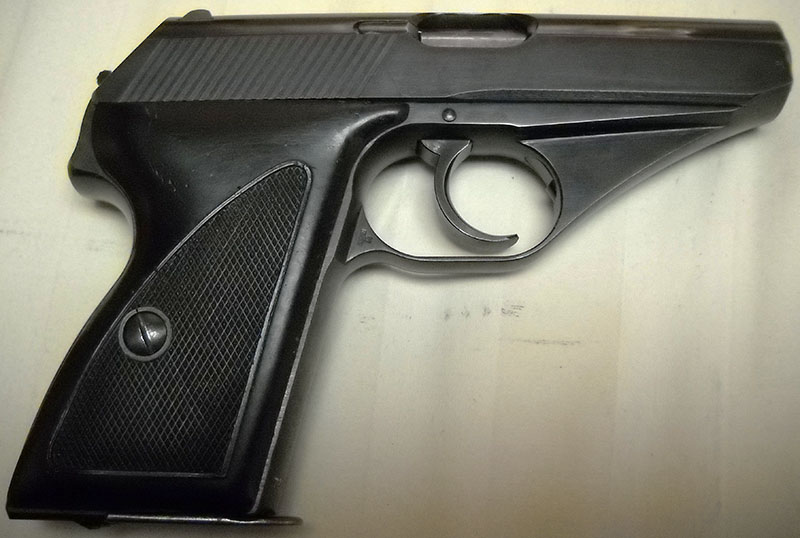
This is a Mauser HSc. Like the PP, it was developed in Germany in the 1930s, intended mainly for the military and police market. Like the PP, it is another of the many, many small automatic pistols designed to use the enormously popular 7.65mm Browning Short/.32 ACP cartridge in interwar Europe. And like the PP, it was bought and issued in large numbers by the armed forces and police services of National Socialist Germany. And yet, whereas the PP and its smaller cousin, the PPK, went on to fame and lasting influence after the war, the HSc has been largely forgotten.
Developed in the late 1930s and commencing production in 1940, the HSc replaced the Model 1934 in Mauser's product line. Despite its name, the Model 1934 was fairly well out of date by that time, being only a mildly updated version of the old Model 1914 (which was itself an updated, slightly larger Model 1910). "HS" stands for the German phrase Hahn-Selbstspanner (literally "Hammer-Selfspanner", as in to span a gap), which is best translated in this context as "self-cocking hammer"—that is, describing a hammer-fired pistol with a double-action trigger mechanism. The "c" just means it's the third version (the HSa and HSb were unproduced prototypes made during development). It has a simple blowback action without any positive locking mechanism, which is not at all unusual for .32-caliber pistols.
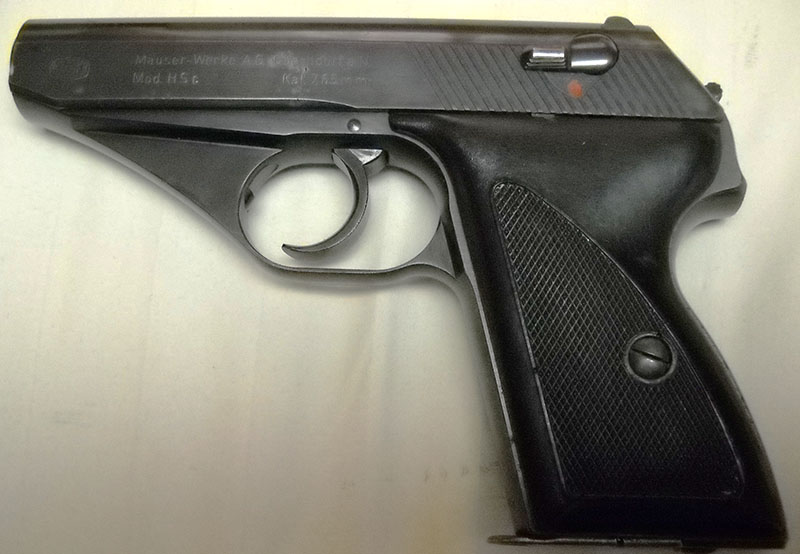
Wartime HScs were purchased by the German Army (Heer) and the Kriegsmarine, as well as various police agencies. A large number of those bought by the army ended up, for one or another bureaucratic reason, being issued to Luftwaffe personnel instead, to the extent that (inasmuch as it's remembered at all) the HSc is now often thought of principally as a Luftwaffe sidearm. They saw service alongside Walther PPs and PPKs, and the Sauer & Sohn 38H (possibly the only German wartime pistol more obscure today)—as well as many other 7.65mm pistols, the German armed forces having hoovered up and redistributed virtually all the offensive hardware in western and central Europe by the middle of the war.
After the war, the Mauser works in Oberndorf am Neckar were in the French Zone of Occupation, and production of the HSc continued under French orders into 1946 before the entire German armaments industry was shut down and the factory dismantled for war reparations. Although West German firms were permitted to resume arms production in the '50s (Mauser rebuilt the works and started up again under its own name in 1952, and a number of its former engineers had gone off and started Heckler & Koch in the same neighborhood in the meantime), the HSc remained out of production until 1968.
Why they started making them again is something I haven't found a solid answer to; possibly it was in response to requests from West German police services, many of whom seem to have issued them. Whatever the reason, this version remained in production until 1977, when Mauser finally stopped making them for good. The late-postwar ones were mostly in 9mm Kurz/.380 ACP, 7.65mm having gone pretty well out of fashion for police use by then. These were also made for the export (read: U.S.) market.
Apart from the 1970s revival, the HSc was the basis for a peculiar variant produced in the '80s by an Italian company called Renato Gamba SpA. This was branded and sold with the Mauser name, but as far as I can tell, never made in Germany. It was called the HSc-80, and was available in .32, .380, and an obscure cartridge called 9mm Ultra, which was developed in the '30s for the use of the Luftwaffe and then adopted by... well, basically nobody. Including the Luftwaffe. The West German police fooled around with it for a little while in the '70s, and then they said what the hell are we doing and standardized on 9mm Parabellum instead. And so 9mm Ultra has, as far as I can tell, basically never been heard from since. Weirdly, the HSc-80 happened after that, so I have no idea why anyone at Renato Gamba thought it would be a good option to offer.
(I originally thought 9mm Ultra, with its 9x18mm case dimensions, was some sort of strange Italian attempt to imitate 9mm Makarov—but with an actually-9mm bullet, as opposed to the Makarov's rather inconvenient 9 and a quarter millimeters. I got that impression largely because the Italians have form for doing things like that; they have an odd law that says no handgun can be made for civilian sale chambering any round used by the Army, and so have to go to bizarre lengths to avoid offering anything in 9mm Parabellum. This law led to the terrifyingly ill-advised 9mm Glisenti cartridge, which has the same geometry as 9mm Para but is much weaker. Which doesn't sound so terrifying until you realize it means you can put 9mm Para ammunition in a gun that's only strong enough to handle 9mm Glisenti.)
Anyway. Strange ammunition aside, I've never seen or handled an HSc-80; accounts I've read indicate that it's heavier than the original (probably because they had to make a cartridge comparable to 9mm Makarov work in a blowback action) and not as comfortable, because they fattened the grip to accommodate a double-stack magazine.
What we're dealing with here is from long before any of that: a commercial HSc from pretty early in production, probably 1941 or 2. Its serial number would suggest otherwise—it's in the 770,000 range—but HSc serialization started around 700,000, because Mauser simply continued the serial numbers from the Model 1934 (despite the fact that the HSc is a completely unrelated product). All told, about a quarter-million of them were made before the end of the original 1940s production run. Since this particular one was not procured for military or police use (unlike many of its neighbors in that production block), it lacks official acceptance marks and bears only the legally required proof mark. This is a strike against it to many Serious Collectors, because the military and police acceptance marks have that exciting swastika eagle thing going on, but I'm funny that way—I rather prefer the items in my collection to have as few swastikas as possible on them.
That doesn't necessarily mean it wasn't carried by a soldier or police officer, since many went and bought their own pistols out of commercial stocks. It just means it was never procured or issued in any official capacity. A great many HScs of this vintage came back from Europe in American hands after the war, and their exact provenance can no longer be determined these many generations later. All I can tell with any confidence from the markings on this one is that it wasn't bought for official issue and it wasn't imported into the United States commercially, at least not after 1968. It has no import markings of any kind, just the original Mauser factory stampings.

They've worn a bit and are hard to make out, but you have the Mauser cartouche on the left, with the company name and location on top (Mauser-Werke A.G. Oberndorf a.N.) and the model and caliber below (Mod. H S c and Kal. 7,65mm). Apart from the serial number, which is at the base of the frame's front strap, and a tiny proof mark on the right-side web of the trigger guard, that's it.
Oddly, I have seen no photographs of any other HSc from this production period with plastic grips. Every other one I've seen a picture of has had plain, uncheckered wooden ones, similar to those on my East German P1001 (the PP "clone, or is it really?" we talked about a while ago). I'm not sure whether this is simply a gap in the photographic record, or if these are aftermarket grips, or what.
As previously discussed, the HSc is a semiautomatic pistol with a conventional single/double-action trigger. It can be fired double-action from a hammer-down position, and subsequent shots are single-action, since the slide recocks the hammer in the usual way. One nice feature of the HSc's system compared with, e.g., that of the Walther PP is that, while it does have an exposed, manually operable hammer, it's not very exposed:
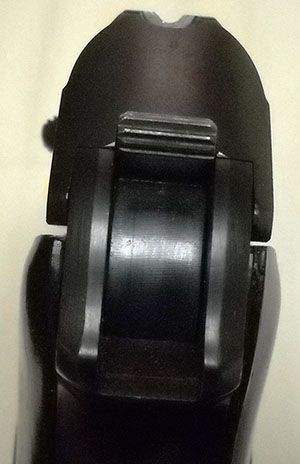
Most of the body of the hammer is enclosed within the slide; only that serrated operating surface protrudes. Some Smith & Wesson revolvers have a shrouded-but-operable hammer like that, but I haven't often seen a setup like that on an automatic. It's a nice touch in what was intended to be usable as a pocket pistol.
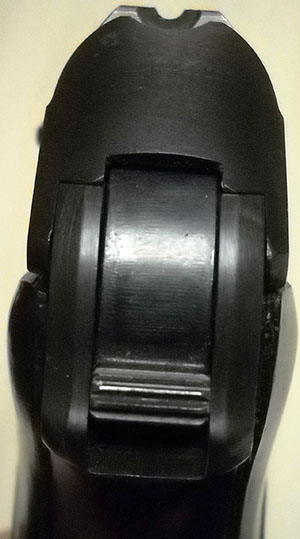
This is what it looks like with the hammer cocked. Nothing extra sticking out in this mode. I have read, though not confirmed firsthand, that the downside to this setup is that, riding as it does in that very confined slot, the HSc's hammer can bite like a mofo despite sticking out hardly at all. I can see where it would, if you have meaty hands and hold a little too high. Perhaps it's not just the weather at the range that makes some of the guys shooting these pistols on YouTube wear gloves.

Sights are... adequate, which is about all you can ask of any firearm of this class and vintage. The top rib has a nice channel in it, with thoughtfully provided matte finishing to reduce glare, and the picture made by the conventional rear notch and front blade is fine in decent light. That was all anyone really expected from a small handgun's sights in the 1930s, and indeed for a considerable time therefter.
One less conventional feature of the HSc's operation is that the slide lock can't be manually disengaged. It locks open on empty, but even with the (8-round, single-stack, pretty typical for the era) magazine removed, it can't be dropped on an empty chamber, as is typical of most modern semiautos. There's neither a manual release nor does the usual pull-back-and-let-go maneuver work. The only way of dropping the slide that I can find is to take the magazine out and put it back. Even if it's empty, this will drop the slide. So, as far as I can tell, if you lose the magazine to your HSc, you are totally out of luck (particularly as it also has a magazine safety).
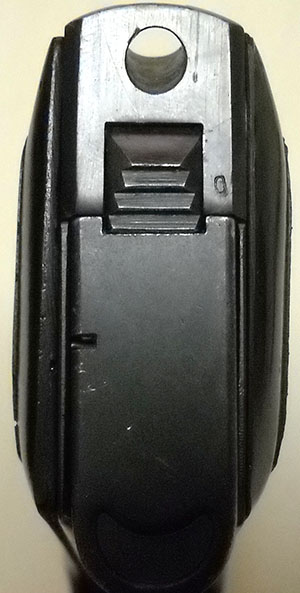
Also typically of small auto pistols of the era (though it was going out of fashion somewhat by the time the HSc was introduced), the HSc has a heel release for its magazine. It's of middling difficulty to operate: doesn't stick out very far, but it's nicely ridged. Also note that this one has a hole for a lanyard in the back of the butt; this feature was eliminated later on. (Another pistol I could put a Japanese cellphone strap on!)
Rather than fart around trying to get still photos of the disassembly process, I'm just going to point you at a video where somebody's already done it. It's pretty tidy, particularly as a thing to encounter after my adventures with the likes of the 1903 Pocket Hammerless and Walther's new CCP.
As a member of the interwar years' legion of European .32-caliber autos, the HSc is a fairly small pistol—one of many that could have benefited from a Walther-style pinky rest attachment to the magazine, though as far as I know it never got one. Here it is in an artsy comparison shot with my East German PP.
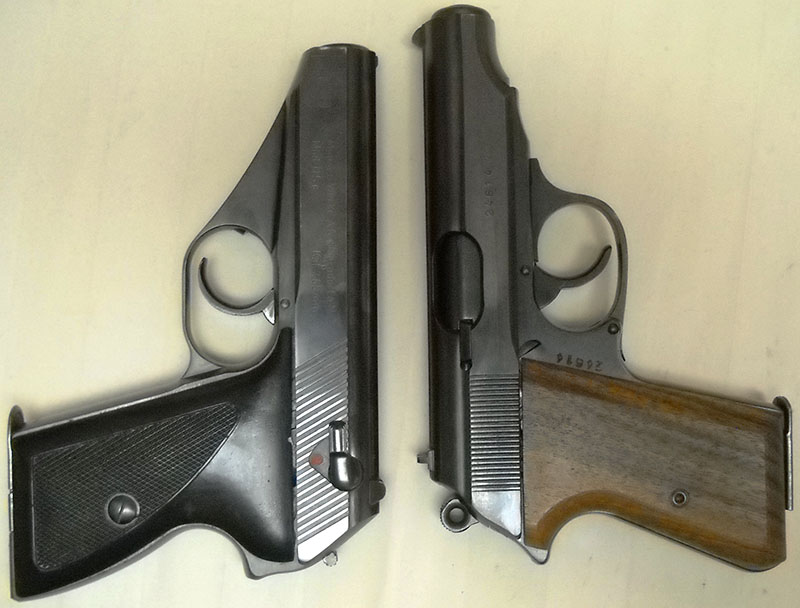
This is an interesting little gun that points up the difference in design sensibility between Germany's two most famous names in small arms at the time. Where the PP has a bit of the Art Deco about it, the HSc is almost ruthlessly streamlined, but not in a bare-bones way; it's just very sleek and functional. Even its little decorative touches, like that web in front of the trigger guard, seem to have a function (in the web's case, I think it's to provide a bit of weight forward for improved balance). Aesthetics were important to Mauser, even in wartime; early in the war, until not very long after my particular one was made, they were still produced with meticulously polished deep-blue finishes that were renowned throughout the industry as the company's hallmark.
As an engineering study, the HSc was a success in what it was asked to do: it was much simpler and less expensive to produce than the gun it replaced, the Model 1934, without sacrificing elegance or usability. Its operation is a bit odd by modern standards, but that's largely because its competitor was the one that ended up so widely imitated that its features became the expected norm. In some parallel universe, the HSc was the one that caught on, and now someone is reviewing a war-vintage Walther PP and saying, "This is a bit odd, but I kinda like it." At any rate, it is nowhere near as peculiar by modern standards as, for instance, the Frommer Stop.
As an aside, the HSc's chief designer, Alex Seidel, went on to be one of the three founders of Heckler & Koch (I'm unsure why he didn't get to put his name on the building too). He was also one of the designers of the wartime StG45(M) prototype assault rifle, which would later evolve (sort of, and with many, many complications) into the successful H&K G3 rifle.
--G.